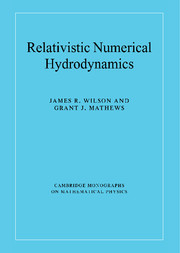5 - Stellar collapse and supernovae
Published online by Cambridge University Press: 11 January 2010
Summary
As discussed in Chapter 3, the treatment of the spherical collapse of a massive star to produce a supernova is sufficiently complex to warrant a separate chapter. It is believed that a Type II supernova arises from the delicate balance between energy deposited by escaping neutrinos from the core and the gravitational energy of collapsing outer layers. Thus, the relativistic energy and mass transport must be considered with high numerical accuracy to obtain a believable simulation. The model discussed herein includes the experience of about 30 years of development and should be of some guidance to those who wish to understand this fascinating phenomenon.
Collapse supernovae
A brief review of the scenario is as follows. Massive stars (i.e. 10 M/M⊙ 30) evolve until the iron core exceeds ∼1–1.3 M⊙. At this point there can be no more nuclear energy generation in the core. Neutrino emission, electron capture, and photodisintegration cool the inner ∼1 M⊙ and remove pressure support from the core. The central density then rises. When the central density ρc approaches ρc 109 g cm−3, neutrino emission is so large that collapse becomes supersonic, i.e vmax > cs, where cs is the speed of sound. As the core collapses, the inner ∼0.7 M⊙ collapses homologously (e.g.). Once the core density exceeds nuclear density, ρc > 2.5×1014 g cm−3, the pressure rises rapidly and collapse is halted. Matter continues to fall inward, however, so an outward moving shock wave is formed. This is referred to as the core bounce.
- Type
- Chapter
- Information
- Relativistic Numerical Hydrodynamics , pp. 117 - 164Publisher: Cambridge University PressPrint publication year: 2003



